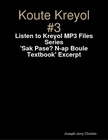Purchase a copy of this cookbook from Barnes and Noble now
Here is a portion of the vocabulary that accompanies this free podcast episode. If you are interested in obtaining a copy of this text, you can download it at Amazon Kindle here.
Find other free blogs and websites that offer free Haitian Creole lessons at http://sakpaselearnhaitiancreole.blogspot.com; http://ezhaitiancreole.blogspot.com; http://aprenderkreyolhaitiano.blogspot.com; http://annpalekreyolaudio.blogspot.com etc.
Ayisyen manje pistach. Yo pito manje manba tou. Yo mete manba sou kasav oswa biswit oubyen pen. Yo renmen chokola ak mòso pen. Yo ka pran kafe ak biswit tou. Pandan lajounen an, yo ka pran akasan ki fèt ak fari-n mayi.
Ayisyen bwè ju anana, ju mango, ju kowosol, ju gwayav, ju papay, ju veritab, ju seriz, ju grenadin (passion fruit), ju abriko, ju grenad, ju kachiman, ju kayimit. Yo ka manje-l konsa aprè yo fin kale-l (wete po-a).
Listen to this podcast:
Vocabulary: Additional Tropical Food Names, Seafood, Ethnic Meals, and Plates
Diri Kole – Rice cooked with beans or other vegetables
Diri blan – White rice
Diri Kole ak djondjon – Rice prepared with black Haitian mushroom
Diri Kole ak pwa wouj – Rice cooked with red beans, maybe pinto beans etc.
Pwa ansòs – Beans with sauce
Bouyon – Stew that comprises lots of vegetables, meat, roots etc.
Bouyon bèf – beef stew
Bouyon kabrit – goat stew
Name Root (yam) – Yanm (kreyol) – Igname (French)
Malanga – Malanga – Malanga (French)
Malanga – Taro Root – Mazoumbelle (French)
Mango – mango (there are many varieties of mangos) – Mangue (French)
Gwayav – Guava – Goyave (French)
Lobster – Oma – Langouste (French)
Labapen – Chestnut – Chataigne (French)
Lam Veritab (Veritab) – Breadfruit – L’arbre a Pain (French)
Cherry – Seriz – Cerise (French)
Piman, piman bouk – Chile (Spanish) – Pepper (English) – Piment (French)
Kokoye Ole – Young Coconut – La noix de Coco (French)
Kokoye – Coconut – Noix de Coco
Mori (Lanmori) – Salt Cod – Moru Salée (French) – Bacalao (Spanish)
Lanbi – Conch – Conque (French)
Kachiman – Custard apple (Sugar apple)
Jiwòf – Clove – Girofle (French)
Kenèp – Honey Berry (Ginep) – Quenèpe (French) – Mamoncillo (Spanish)
Zaboka – Avocado – Avocat (French) – Aguacate (Spanish)
Rache – Chop – Hacher
Konsonmen (Konsome) – Vegetable Consommé
Griyo – Grilled pork often sold by street cooked food merchants or peddlers; The meat can be of other kinds too. It could be goat, beef or guinea fowl.
Pentad – large Haitian chicken-like bird, guinea fowl.
Bannann – Plantains – Bananes (French)
Bannann peze – Twice pressed fried plantains
Fig – banana
Kreson – Watercress – Cresson (French)
Epis – Spices – Epices
Fig Mi Flanbe – Flamed bananas – Bananes flambées
Tomat – Tomatoes – Tomate (French)
Diri kole ak pwa epi kawòt – Rice with green peas and carrots
Lanbi ak sòs – Conch in Creole sauce
Poul ak sòs – Chicken with sauce
Salad Zaboka – Avocado Salad
Avwa-n – Wheat
Ble – Wheat (meal)
Ji seriz – Cherry juice – Jus de cerise
Diri olè – Rice Pudding – Du Riz au lait
Pen Mayi (Doukounou) – Cornmeal pudding – Pudding de Mais Moulu (French)
Moulen – Mill – Moulin (French)
Grate – to grate – Grater
Chou – Cabbage – Chou (French)
Jele gwayav – Guava Jelly – Gelée de Goyave
Konfiti Anana – Pineapple Preserves – Confiture d’Ananas (French)
Kribich Fri ak sòs – Fried Shrimp with sauce – Crevettes frites et sauce
Dous Kokoye – Coconut milk candy – Fondants au lait de Coco
Donbwèy – rolled flour or manioc flour cooked in bouyon
Soup joumou – Pumpkin soup – Soupe de Citrouille
Kasav – Cassava (Tortilla-like edible made with tuber named manioc)- Cassave
Purchase a copy of "Haitian Foods and Fruit Names, Haitian Creole Cuisine, Haitian Recipes, Recettes Haitiennes, Recetas Haitianas"
List of Fruits Haitians Consume
apples - pòm
cherries - seriz
banana - fig
grapes - rezen
oranges - zoranj dous
sour oranges - zoranj si
grapefruit - chadèk
pineapple - anana
mango - mango
Soursop - kowosòl
papaya - papay
pomegranate - grenad
limes -sitwon vèt
lemon - sitwo jòn
guava - gwayav
List of Vegetables Consumed by Haitians
Spinach - zepina
potatoes - pòm de tè
sweet potatoes - patat
cabbage - chou
onions - zonyon
eggplant - berejèn
cucumber - konkonm
watercress - kreson
carrot - kawòt
celery - seleri
tomatoes - tomat
lemon, lime - sitwon
lettuce - leti
avocado - zaboka
coconut - kokoye
chayote squash - militon
Purchase a copy of "Haitian Foods and Fruit Names, Haitian Creole Cuisine, Haitian Recipes, Recettes Haitiennes, Recetas Haitianas"
Get a copy of "Haitian Gastronomy: What Do Haitians Eat....? right on this page.
Purchase a copy of "Haitian Foods and Fruit Names, Haitian Creole Cuisine, Haitian Recipes, Recettes Haitiennes, Recetas Haitianas"
Additional Vocabulary, phrases, and Expressions
M pral pase rad - I am going to iron clothes
De nada - De Rien - Padekwa, pa gen pwoblem
Sa-k Pase? - What's up?
N-ap Boule - We are doing fine / We are fine


















































